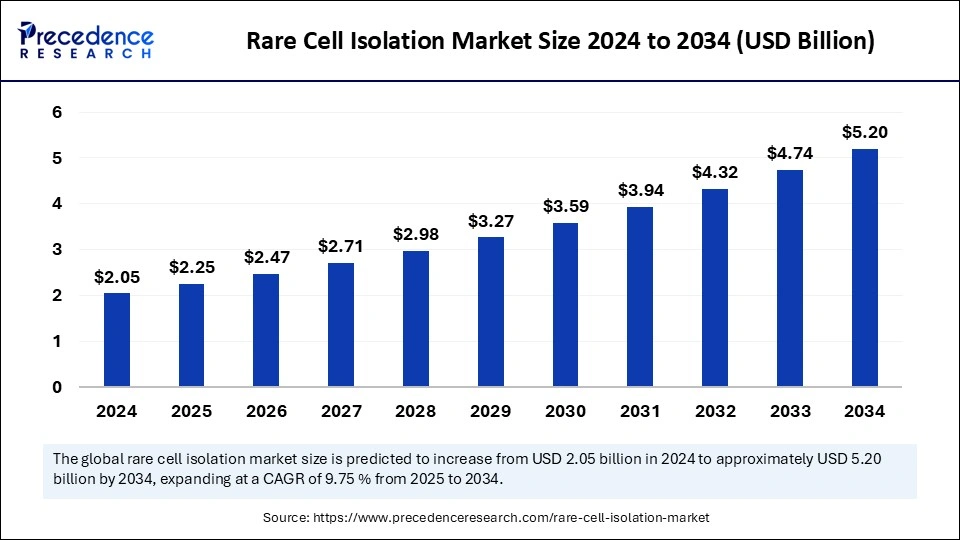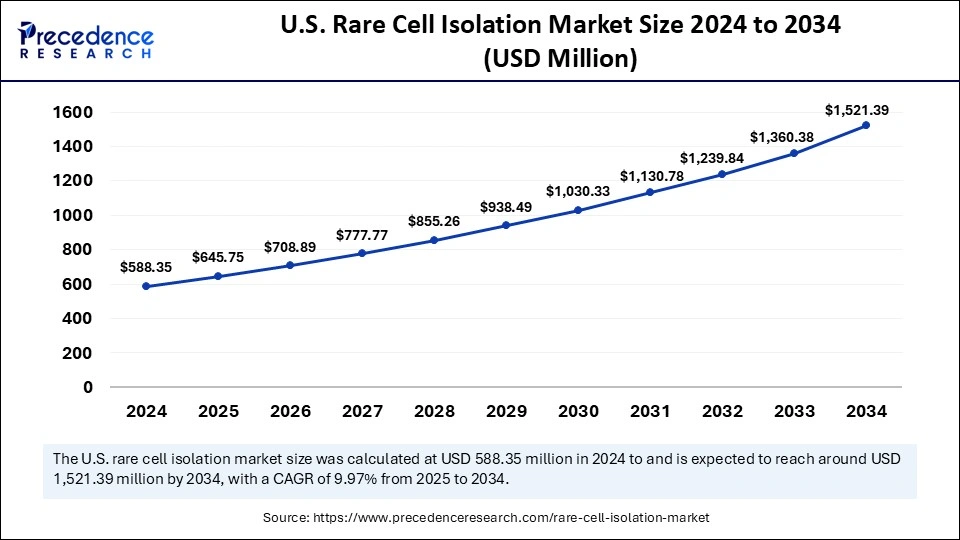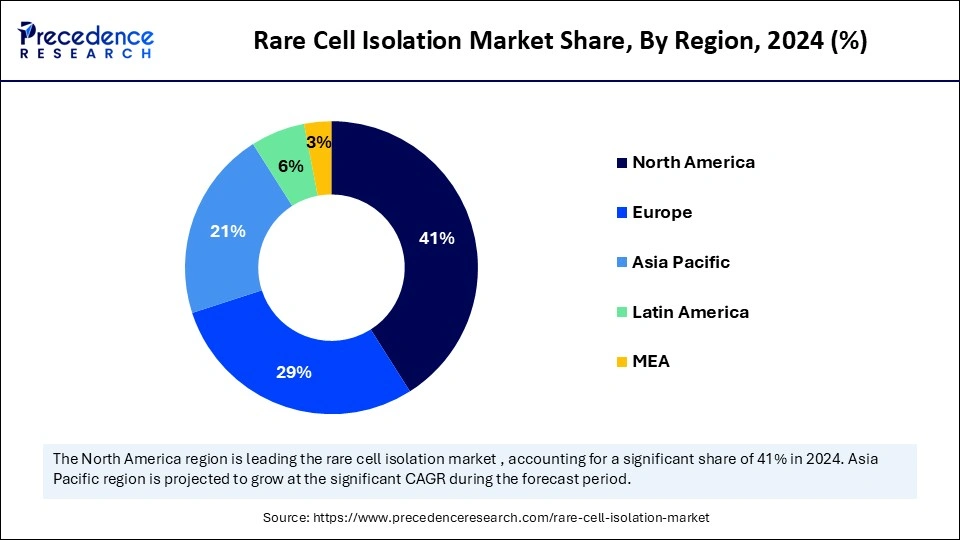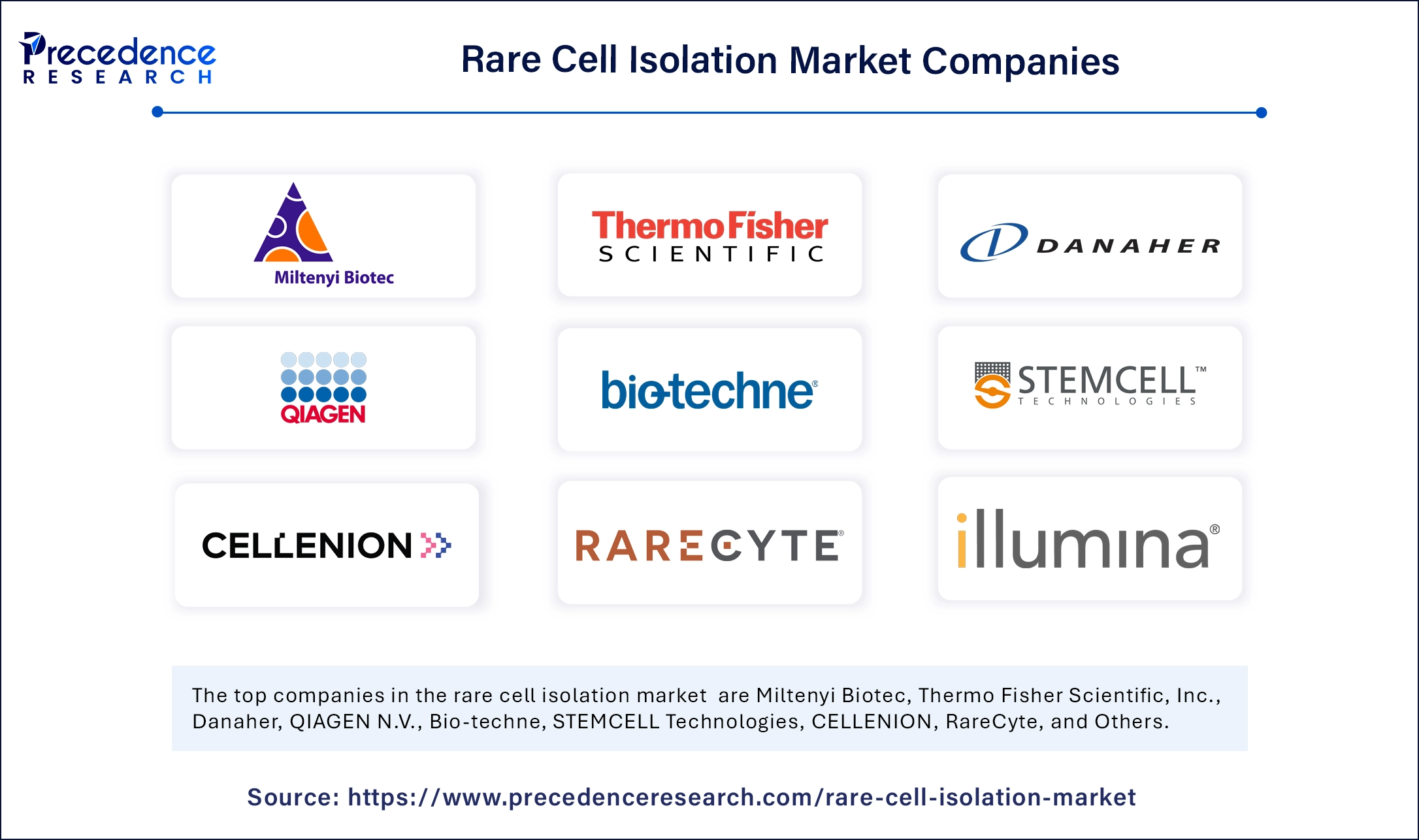February 2025
The global rare cell isolation market size is calculated at USD 2.25 billion in 2025 and is forecasted to reach around USD 5.2 billion by 2034, accelerating at a CAGR of 9.75% from 2025 to 2034. The North America market size surpassed USD 840.05 billion in 2024 and is expanding at a CAGR of 9.89% during the forecast period. The market sizing and forecasts are revenue-based (USD Million/Billion), with 2024 as the base year.
The global rare cell isolation market size accounted for USD 2.05 billion in 2024 and is predicted to increase from USD 2.25 billion in 2025 to approximately USD 5.2 billion by 2034, expanding at a CAGR of 9.75% from 2025 to 2034. rising demand for precision medicine is expected to boost the growth of the market during the forecast period.

Artificial Intelligence (AI) is finding applications in the biopharmaceutical, biotechnology, and healthcare sectors. In rare cell isolation, AI can be utilized for the acceleration of research and development activities. AI technology combined with machine learning (ML) can analyze huge amounts of datasets to determine which outcomes are likely to succeed. This helps researchers redirect their focus to higher probability outcomes, which helps save time and costs. AI can help with various research and development activities like cancer research, immunotherapy, personalized medicine, and regenerative medicine.
The processes of research can become more efficient, reliable, and cost-effective with the use of various AI-driven systems. With AI-driven tools, the cells can be isolated and analyzed to detect cancer early, which helps clinical applications along with better patient outcomes. Automation becomes easier with the AI system as it helps optimize the cell sorting processes, which reduces the time and resources required. AI technology helps enhance the accuracy of identifying rare cells, boosting the research and clinical application processes.
The U.S. rare cell isolation market size was exhibited at USD 588.35 billion in 2024 and is projected to be worth around USD 1,521.39 billion by 2034, growing at a CAGR of 9.97% from 2025 to 2034.

North America held the largest share of the rare cell isolation market in 2024. This is mainly due to the presence of major biotechnology companies and research institutes. This region has a well-established healthcare and research infrastructure, supporting market growth. The demand for targeted therapies and regenerative medicine has increased in the region due to the increased burden of chronic diseases, such as cancer.
The U.S. plays a crucial role in the growth of the market in North America. The rising number of cases of chronic diseases in the country is propelling the growth of this market. According to the American Cancer Society, there were 2,001,140 new cancer cases in the U.S. in 2024. Such a rise in cancer cases boosts the need for cancer research, directly impacting the growth of this market. The rising government funding for cell research is also driving market growth.
Asia Pacific is expected to witness the fastest growth during the forecast period. The increasing prevalence of chronic diseases is a major factor boosting the growth of the market in the region. Governments around the region are investing heavily in novel drug discovery and development, in which rare cell isolation is crucial for assessing drug efficacy and safety. There is a growing preference for rare cell isolation technologies in therapeutics, which further support market growth. China is likely to have a stronghold on the market. This is mainly due to the strong focus on developing regenerative medicine. The rising cancer burden and increasing investments in stem cell research further contribute to market expansion.

Europe is considered to be a significantly growing area. The growth of the European rare cell isolation market can be attributed to the rising investments in research and development activities focusing on cell-based therapies. There is a high demand for personalized medicine and regenerative medicine for cancer treatments. The rising prevalence of chronic diseases further contributes to the growth of this market. The UK plays a significant role in the growth of this market. The country’s well-established healthcare and research infrastructure and the expansion of the biotechnology sector are expected to support market growth.
Rare cell isolation refers to the method used to separate a small population of cells, which further helps in further study or analysis. The rare cell isolation market has been expanding rapidly due to the increasing prevalence of chronic diseases, such as cancer. The rise in cancer cases worldwide is boosting the demand for advanced treatments, therapeutics, and diagnostics, significantly prompting the demand for rare cell isolation technologies. Technological advancements in the field of cell isolation have improved the accuracy, precision, and reliability of these techniques, sustaining the long-term growth of the market.
The increased accessibility to cell isolation technologies for clinical and research applications is driving the growth of this market. The rising investments across the world for stem cell research are propelling market growth. An increase in demand for personalized medicine, targeted therapies, regenerative medicine, and advanced therapeutics is fueling the growth of this market.
| Report Coverage | Details |
| Market Size by 2034 | USD 5.2 Billion |
| Market Size in 2025 | USD 2.25 Billion |
| Market Size in 2024 | USD 2.05 Billion |
| Market Growth Rate from 2025 to 2034 | CAGR of 9.75% |
| Dominated Region | North America |
| Fastest Growing Market | Asia Pacific |
| Base Year | 2024 |
| Forecast Period | 2025 to 2034 |
| Segments Covered | Product, Cell Type, Technology, and Regions |
| Regions Covered | North America, Europe, Asia-Pacific, Latin America and Middle East & Africa |
Increasing Stem Cell Research and Demand for Regenerative Medicine
The increasing stem cell research is one of the major factors driving the growth of the rare cell isolation market. Stem cell research involves isolating and manipulating rare stem cell populations for further study and analysis. This, in turn, boosts the demand for efficient rare cell isolation techniques. Moreover, the rising demand for regenerative medicine is another key factor driving the growth of the market. Regenerative medicine is a field that aims to replace or repair damaged tissues, cells, and organs through unique techniques. This method depends on stem cells because of their capacity to differentiate between different cell types.
Rising Focus on Drug Discovery
With the rising prevalence of chronic conditions across the world, there is a strong emphasis on novel drug discovery and development. Rare cell isolation techniques find applications in drug discovery, as they play a crucial role in assessing drug efficacy and identifying potential toxicity. Increasing government investments in drug discovery further propels the growth of the market. Moreover, rising funding for cell research is driving the growth of this market.
Regulatory Compliance
Regulatory compliance poses a significant challenge for the rare cell isolation market. With the rising development of cell isolation technologies, there have been stringent regulations regarding patient safety and data security. These regulations can also differ from region to region, limiting the growth of this market. The ethical aspect of this market is an important consideration for cell isolation processes. Countries across the world have advisory boards or even bioethical committees to examine the implications of cell isolation tools.
Technological Advancements
Continuous advancements in technology create immense opportunities in the rare cell isolation market. Advancements in cell isolation techniques help researchers rapidly isolate cells, accelerating research activities and enhancing outcomes. Innovative technologies like AI and the Internet of Things can improve cell isolation techniques. These technologies have the ability to automate cell isolation processes. In addition, advanced technologies help researchers allocate proper resources, analyze data, and save time.
The reagents & kits segment led the rare cell isolation market with the largest share in 2024. Continuous improvements and enhancements in reagents & kits have helped boost their efficiency. Reagents & kits play a crucial role in cell isolation processes. They are specifically designed to improve the specificity and sensitivity of the cell isolation method, which makes them crucial for clinical as well as research applications. Kits encompass the required components, which help reduce the time and complexity of the isolation process.
Meanwhile, the instruments segment is projected to grow at a rapid pace during the forecast period. The growth of the segment can be attributed to the high emphasis on improving the accuracy, precision, and efficiency of rare cell isolation techniques. Ongoing technological advancements led to the development of sophisticated instruments designed for rare cell isolation, contributing to the growth of this segment.
The stem cell segment dominated the rare cell isolation market in 2024. The growth of the segment is driven by the increased funding for stem cell research. Cell isolation plays a key role in stem cell research. With the rise in number of cases of chronic disease across the world, the demand for personalized medicine and regenerative medicine has increased, in which stem cells are essential. These cells have unique characteristics like regenerative abilities and therapeutic potential, making them suitable for regenerative medicine and targeted therapies.
On the other hand, the rare immune cells segment is anticipated to expand at a significant rate in the upcoming period. The increasing prevalence of rare diseases is expected to support the growth of the segment. In addition, ongoing research activities focusing on rare diseases support segmental growth.
The microfluidics-based techniques segment led the rare cell isolation market in 2024. The segment growth is driven by the heightened adoption of microfluidics-based cell isolation techniques due to its high throughput. This technique has proven to have several benefits and capabilities to drive innovation, making it an attractive choice for clinical and research applications. The microfluidics-based technique enables precise control and manipulation of fluids at a microscale. It helps improve the accuracy of the isolation of rare cells.
Meanwhile, the magnetic bead separation segment is projected to grow at the fastest rate during the projection period. This technique is compatible and highly adaptable with different downstream applications. Therefore, it is widely used in research and clinical applications. Continuous advancements in this technique will help the growth of this segment.

By Product
By Cell Type
By Technology
By Region
For inquiries regarding discounts, bulk purchases, or customization requests, please contact us at sales@precedenceresearch.com
No cookie-cutter, only authentic analysis – take the 1st step to become a Precedence Research client
February 2025
February 2025
January 2025
January 2025